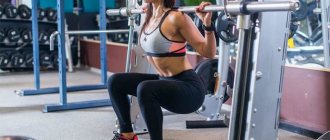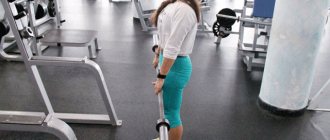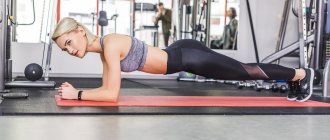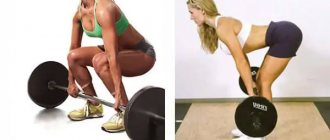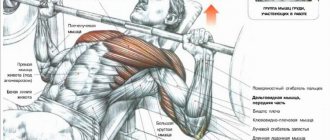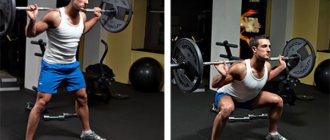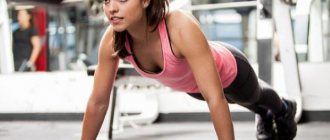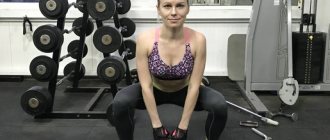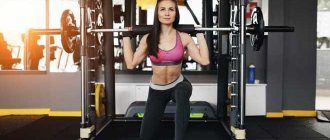Author: Timko Ilya - the ruler of the entire site and fitness trainer | more details >> Rod. 1984 Trained since 1999 Trained since 2007. Author and creator of the site tvoytrener.com. CCM in powerlifting. Champion of Russia and South Russia according to AWPC. Champion of the Krasnodar region according to IPF. 1st category in weightlifting. 2-time winner of the Krasnodar Territory championship in t/a. Author of more than 700 articles on fitness and amateur athletics. Author and co-author of 5 books.
Place in the author rating:
out of competition
(become an author) Date: 2012-05-29 Views: 462,580 Rating: 5.0
| All articles by the author >> | Medals articles >> |
Articles are loading...
| Article medals: | more than 100 thousand views |
Why medals are given to articles:
| Bronze medal: | |
| 1. The article is in the TOP 100 2. The article has more than 3. The article has more than 100 | |
| Silver medal: | |
| 1. The article is in the TOP 50 2. The article has more than 3. The article has more than 500 | |
| Gold medal: | |
| 1. The article is in the TOP 10 2. The article has more than 1 3. The article has more than 1,000 | |
Main muscles - gluteus maximus Additional - back of the thigh Difficulty - medium
V. How exercise therapy works
The spinal extensor muscle bundles are located in several layers.
On the outside are the longest bundles, extending over one and a half dozen vertebrae. The longissimus dorsi muscle has bundles that connect the lumbar and cervical spine. It is these bundles that create the cervical-tonic effect - an increase in back strength with an extended neck. In the middle layers there are bundles of muscle fibers connecting the vertebrae of one or two sections of the spine. Closer to the spine lie fibers connecting several vertebrae. Directly at the spine are the shortest fibers that connect two adjacent vertebrae. It is the fibers closest to the spine that are most responsible for its health. It is their strength and elasticity that can prevent displacement and hernias. When performing rows and bends, the main work is done by long and medium beams. And when performing hyperextensions, the shortest fibers do not work enough. In terms of their effect on the spine, hyperextensions are classified as therapeutic and preventive exercises. But hyperextension and exercise therapy do not replace each other, they complement each other, as they affect different layers of the back muscles.
The task of the exercises proposed to you is to force the shortest fibers of the back muscles, which are little loaded in other exercises, to work, and at the same time to stretch them. This can be achieved by forcing the spine to bend in certain areas with the maximum possible amplitude. To achieve a goal, you need to exert yourself with efforts close to the limit. Maximum effort, lasting several seconds, should be alternated with relaxation. Stretching and relaxation are designed to combat pockets of chronic tension arising from static load.
Exercise therapy will not replace traditional stretching methods, the effects of which are aimed at the large muscles of the body. Traditional stretching and exercise therapy complement each other.
The benefits of exercises for the pelvic organs
Training any muscle always has a positive effect on the body as a whole. The same applies to training the pelvic muscles.
Positive effects
Performing specially selected exercises allows you to achieve the following effects:
- Accelerate blood circulation in the pelvic organs, thereby increasing the rate of delivery of nutrients, oxygen and removal of metabolic products. This leads to the activation of the processes of hormone synthesis in the prostate gland, which causes an increase in potency, the process of formation of new sperm and seminal fluid proceeds more quickly and fruitfully, which significantly improves the functional characteristics of sperm.
- Improve the outflow of venous blood from the vessels of the pelvic cavity, which is the most effective prevention of the formation of hemorrhoids and the development of inflammatory processes in the prostate gland, seminal vesicles and bladder: stagnant blood leads to an increase in local temperature and the creation of a favorable environment for the proliferation of various microorganisms that cause inflammatory diseases.
- Strengthen the peristalsis of the lower intestines, thereby having a beneficial effect on its work.
- Involve the lower parts of the spinal tract in movements, thereby activating nutrition and metabolic processes in their intervertebral discs and eliminating existing muscle spasms, which is a prevention and measure to combat degenerative processes in the intervertebral joints, including osteochondrosis.
- Strengthen the muscles of the buttocks and lower abdominals, that is, improve your figure.
Strengthening the muscles of the pelvic floor
The anatomical area associated with the small pelvis, such as the pelvic floor, deserves special attention. At its core, it is a complex of muscles that bear the weight of all the abdominal organs and, in particular, the pelvic organs. It is they who do not allow these organs to fall down and be pinched by the bones that form the pelvis - this is a kind of hammock that can sag somewhat under the weight of the organ complex, but must have sufficient elasticity so as not to stretch and sag completely.
Particularly important is the fact that the pelvic floor muscles are not smooth, but striated muscle tissue, which means that it can be trained. It is known that the pelvic floor muscles work actively during lifting weights, during bowel movements, urination and sex. The weakness of one of the muscles located in the pelvic floor is associated with such an unpleasant condition in men as the release of a few drops of urine after urination.
Observations show that the muscles on the pelvic floor are quite amenable to conscious control, that is, they can be tensed and relaxed at will.
In addition, performing exercises for the purpose of prevention is much simpler, without pain, which often occurs if the same exercises are performed when some pathological process is already taking place in the pelvic organs.
Execution technique
To perform the pelvic lift exercise while lying down, take the following position:
- lie on the floor, stretch your arms along your body and press them to the floor with your palms down;
- bend your legs at the knees and pull them as close to the buttocks as possible;
- make sure your fingers are pointing towards your heels;
- Keep your feet and knees hip-width apart;
- press your shoulders and body tightly to the floor surface;
- raise your toes slightly, focusing on your heels.
After this, start the exercise:
Lift your pelvis up so that your body forms a straight line with your hips. Make sure the emphasis is on your heels
This is an important condition that guarantees the correct lifting technique and gives maximum load on the gluteal muscles. You should not feel any tension in your back. Having reached the top point of the movement, tighten your buttock muscles as much as possible.
Maintain this position for 2-5 seconds. Make sure that during the entire exercise the load falls on the buttocks, and not on the quadriceps. In the latter case, you are clearly doing something wrong. Lower yourself down slowly over 1-2 breaths, avoid jerking and sudden movements. Try not to touch the floor with your buttocks. This will allow you to keep your muscles toned throughout the entire exercise. Ideally, at the bottom of the exercise, there should be 3-5 centimeters between your body and the floor.
Do not turn your head from side to side while performing the movement. This can cause injuries to the cervical spine. And just pulling a muscle will be unpleasant. The gaze should be directed strictly upward.
Adhering to the indicated amplitude, do 15–20 repetitions. Take a break for 1 minute and repeat the entire exercise 1-2 more times.
Common execution errors
Many people do not achieve the desired effect from this technique due to very common mistakes when performing it. In most cases, they include the following shortcomings:
- Incorrect starting position: The legs should be positioned so that there is a small distance between the heels and hands. It is advisable for the practitioner to reach his heels with his fingers.
- Emphasis on the toes: often the maximum height of the raised pelvis leads to emphasis not on the heels, but on the toes. Therefore, it is important to remember that the feet must remain pressed to the surface of the mat throughout the entire session.
- Prolapse: it is necessary to maintain a distance between the buttocks and the floor of at least 3-4 cm. This way, the load and tension will not be in vain.
- Large additional loads: when combining lifts with other exercises, it is not recommended to abuse heavy weights, which can disrupt the training technique.
By eliminating such mistakes, you can achieve noticeable results after just a month of regular exercise.
Correct pelvic lift technique
Many athletes, including those who have been visiting gyms for many years, can make annoying mistakes that make the exercise simply useless.
Here is what technique you need to adhere to in order for your classes to be effective:
- We lie on our backs, arms lie along the body;
- We bend our legs at the knees and press them towards the butt;
- Feet and knees are hip-width apart (that is, they are not standing together);
- We place our feet on the heels;
- We press our head and shoulders tightly to the floor - they should not move during work.
Now you can start the exercise. The pelvis is raised so that the hips and torso form a straight line.
Having risen, we are not in a hurry to lower ourselves, we fix the position for 2-3 seconds so that the muscles tense as much as possible. We make sure that the load falls on the buttocks.
Now we lower ourselves slowly, controlling the tension in the muscles. No need to fall or put your butt on the floor. When lowering, approximately 2-4 cm should remain between the floor and buttocks - this will allow the muscles to remain in working condition throughout the entire exercise.
For beginners, you can do 15-20 repetitions with breaks between sets of 1-2 minutes.
It is very important to maintain the starting position with your palms, shoulders and head pressed to the floor. No need to look to the sides or turn while performing the workout
This can lead to sprains or injuries.
Many people ignore warming up before training - this is a mistake. Before putting stress on the muscles, they need to be warmed up.
This is done in order, firstly, to increase their work limit, and secondly, to ensure that they receive sufficient oxygen and nutrients during training.
Don't be lazy to warm up before class. This won't take much time and will only improve your training results.
The pelvic lift is a great exercise for those who are just starting to work on their figure - it is a basic exercise that can be easily done at home.
Basic recommendations and precautions
The need for moderate physical activity during pregnancy can be characterized by the motto “It is better to sit than to lie down. Better standing than sitting. It’s better to walk rather than stand.” Everything needs moderation. Organized physical activity in the absence of contraindications will not harm anyone, including pregnant women. If you don't want to exercise, you can swim. If you don't like swimming, there is breathing practice and yoga. When none of the above sparks enthusiasm, try dancing or walking more outdoors. You can choose a type of activity that will be useful and enjoyable at the same time.
The main recommendations are as follows:
- do not overheat during training - this has a negative effect on the child;
- drink more water to stimulate the removal of toxins and normalize metabolism;
- the optimal time for training is 2 hours after breakfast;
- avoid excessive stress. The presence of shortness of breath in the mother means that the baby receives less oxygen;
- control your well-being. The presence of pain in the lower abdomen is a signal to stop exercising;
- there is no point in overworking: 15 minutes is enough to stretch your muscles;
- try not to do exercises during periods when “critical days” were supposed to occur;
- do not forget about proper breathing and relaxation.
Pregnancy is a crucial period when a woman should take care of her body. If there is no evidence, there is no point in lying on the couch for 9 months. Physical education will help prepare the body for childbirth, reduce pain, improve metabolism and avoid gaining excess body weight.
Benefits of the Glute Bridge
Raising the pelvis from a lying position is one of the variants of such a well-known exercise as the bridge. However, compared to the classic bridge, this movement does not place excessive stress on the spine.
The beneficial properties of the exercise include:
- The glute bridge is excellent for targeting the gluteus maximus while also targeting the hamstrings.
- The exercise can be performed at home without any complex equipment, just a fitness mat (or a large towel) is enough. To complete the exercise you will only need 10-15 minutes of free time.
- The supine glute raise is an effective buttock development exercise that can be performed comfortably by both beginners and more experienced athletes. At the same time, in general the movement is quite safe; however, if you experience any discomfort in the lumbar region or knee joints while performing it, you should pause your current workout and consult a therapist.
- Everyone knows the bridge exercise from high school or college classes. As a rule, lifting the pelvis while lying on your back does not cause any serious difficulties. It is performed by both children and adults. Therefore, you can safely include this movement in your training program and perform it regularly.
Technique for performing the gluteal bridge exercise:
- Lie on the floor on your back, arms at your side, knees bent. Your feet should be shoulder-width apart. This is your starting position.
- Using the heels of your feet to press into the floor, lift your hips off the floor while keeping your back straight. Perform this part of the movement as you exhale and hold the position at the top of the range of motion for a second.
- As you inhale, slowly return to the starting position.
Execution options:
- You can perform this exercise by lifting one leg at a time.
- If a regular glute bridge is very easy for you and you want to add intensity to the load in the exercise. You can use a barbell plate or dumbbell as additional weight.
- There is also a variant of the exercise, lifting the pelvis from a lying position with a barbell. This exercise is suitable for more experienced practitioners.
- In addition, there is a variant of the exercise in which, for additional load, the legs are placed on a bench or platform, which also increases the intensity of pelvic lifts from a lying position.
By the nature of the load, the gluteal bridge belongs to the type of isolated exercise. This circumstance makes it reasonable to combine it with other compound exercises aimed at working the lower body, such as stiff-legged deadlifts or squats with dumbbells.
Before you begin direct pelvic lifts, you need to do a general warm-up and warm up your muscles well. Aerobic exercises, such as slow running or jumping rope, are good for this purpose. A 10-minute warm-up will be sufficient and your body will be ready for exercise.
Technique for performing the gluteal bridge exercise with a barbell:
- Begin the exercise sitting on the floor with a loaded barbell above your feet. Using bar extensions or a bar pad can greatly reduce the discomfort caused by barbell pressure in this exercise. Place the bar so that it is directly above your hips and lie flat on the floor.
- Begin an upward movement by pressing your heels into your feet, extending your hips with the bar resting on them. The weight of the barbell should be supported by the support of the upper back and the heels of the feet.
- Once you reach the top position as far as possible, slowly reverse the movement to return to the starting position.
Thus, lifting the pelvis while lying down is a simple, but overall extremely effective movement. Regular exercise will allow you to achieve good results, namely, your buttocks will become toned, their shape will improve, problem areas will be worked out, and overall tone will appear. Combine glute bridges with cardio training, and you can noticeably improve the condition of your figure, which will please you and those around you.
Once your muscles are stronger, you can progress the load level of the exercise by using additional weights, such as a barbell or dumbbells.
Video: Glute bridge exercise:
Owner by car number - how to find out the owner of a car by number bibikatut.ru.
Benefits of Exercise
The glute bridge exercise is popular among both men and women because it has so many benefits. Firstly, pelvic lifts are effective for burning excess calories - they are actively used to combat excess weight, which, according to research, occurs in every second Ukrainian and can cause serious chronic diseases.
Secondly, the exercise has a positive effect on many muscles , which include the abdominal area and buttocks, and since, according to another study, the abdominal abdominal muscles support all internal organs, the training will have a positive effect on overall health and will reduce the risk of serious diseases.
Thirdly, the gluteal bridge improves blood circulation in the lower pelvic organs , reducing the risk of gynecological diseases in women, which, according to research by a candidate of medical sciences, have recently become increasingly common.
In addition to the listed benefits, regularly performing the gluteal bridge has several more advantages:
- provides deep work of the gluteal muscles without excessive stress on the spine and knee joint;
- a wide variety of techniques allows you to choose the optimal one, simplifying or complicating the training;
- ease of execution and no need to use additional equipment (if you choose the classic option);
- can be used for preparation - the exercise strengthens and gives strength to the muscles that are involved in cardio training.
The gluteal bridge is an isolating exercise; it is advisable to include it in a training block or combine it with aerobic exercise.
Advanced Glute Bridge with Leg Raise and Weight
VI. Description of exercises
To perform exercise therapy, you need a coating that will provide sufficient adhesion to your clothing or body. The covering must be secured in a stretched state.
1. Lumbar twisting. 2 options
IP (starting position) Lying on your back, hands behind your head, legs bent at the knees. In the 1st option - the heels are together, in the 2nd - the distance between the heels is equal to the length of your shin.
We tilt our knees to the sides one by one, trying to place our closed knees on the floor (in case 2, our knees lie separately in different places). We monitor the position of the elbows; they should remain pressed to the floor. If you lack flexibility, you will need the help of assistants who will press your elbows and knees to the floor, avoiding excessive traumatic forces. If you have good flexibility and can easily perform the exercise on your own, place a pillow under your pelvis. This will increase your range of motion and better stretch your lower back.
2. Thoracic twists
IP: lying on your back, arms up, fingers intertwined.
Keeping the pelvis pressed to the floor, we raise the shoulder blade and bend the spine forward in the thoracic region, while simultaneously twisting it to the side. We try to do the exercise with the maximum possible amplitude in both directions.
3. Caterpillar in 2 directions
Forward. IP: Lying on your back, knees bent, arms up.
Having removed the arch in your lower back, raise your shoulders and place them as far away from your legs as possible. Bend your lower back as much as possible. At the same time, your pelvis should move towards your head. After several repetitions, move your heels closer to your pelvis, this will return you to IP. Back. IP: Lying on your back, knees bent, arms to the sides - lie relaxed.
Leaning on your heels and shoulder blades, lift your pelvis, while keeping your thoracic region on the floor. Place your pelvis as close to your heels as possible. Lift your heels off the floor. Bend your lower back as much as possible. At the same time, your shoulder blades should move towards your legs.
4. Lizard in 2 directions
Forward. IP: Lying on your back, legs down, arms up.
“Stepping over” with the shoulder blades, we move towards the head.
Back. IP: Lying on your back, arms resting freely in the direction of your head, legs raised above the floor.
“Stepping over” with the pelvis, we move towards the legs.
5. Raising the pelvis with the lower back pressed and moving it to the sides
IP: Lying on your back, legs bent, arms folded on your chest.
Press your lower back to the floor. Raise your pelvis without lifting your lower back from the floor. Use the rectus abdominis muscles to lift the pelvis, exclude assistance from the legs. Alternate maximum tension of the rectus muscle with relaxation in the position of the legs and arms lying on the floor. Return to IP. Raise your pelvis and, without lifting your lower back from the floor, shift it alternately to the sides, as far as possible.
6. Wave in 2 directions
IP: Lying on your stomach, palms under your forehead.
We send a wave along the spine towards the head, after 5-6 waves of relaxation, 5-6 waves along the spine towards the legs, relaxation... and so on.
7. Stretching on the stomach, legs secured
This exercise does not train muscles, it helps to completely relax after exercise.
Lying on your stomach, tie your legs to the furniture or to the exercise machine with a rubber band.
You can bend over with your hands. Rolling over your stomach, move forward, while the tension of the rubber should increase. Relax your lower back after each movement. Repeat several times. With the rubber band stretched and the lower back relaxed, move the pelvis to the sides.
- Lower back injuries from strength training
- How to exercise if your back hurts: step-by-step instructions
- How to choose exercises for pain/diseases of the spine
- I tore my back during training, what should I do?
- Schmorl's hernia: causes, symptoms, treatment
Page added to favorites Page removed from favorites
Transverse abdominal muscle training. Tupler technique
It consists of repeated retraction of the abdominal wall while sitting, lying and standing. The palms of your hands or a long piece of cloth are used to control muscle contraction. The basic Tupler exercise is to move the navel toward the spine without holding your breath. It is most convenient to perform it while sitting on the floor with reliable support behind your back, legs crossed. Place one palm on the solar plexus, the other under the ribs and, as you exhale, try to move the navel towards the spine and slightly hold it. Do this for 100 movements, counting them out loud (time interval is approximately 2.5 minutes). Perform up to 5 such approaches per day, ending with Kegel exercises. With a strong degree of diastasis, the abdomen is wrapped in a long piece of cloth (towel), holding its ends in the hands. As you exhale, the towel is pulled over your stomach, helping the muscles contract, and held at the point of maximum compression for a second. The number of repetitions in this case is reduced to ten. Regular exercise tightens the abdominal wall within a few weeks.
What muscles work
Let's look at what muscles work during the glute bridge exercise:
- large, medium and small gluteals;
- biceps femoris muscle;
- back and front of the thighs;
- calf muscles;
- core muscles;
- spinal extensor muscles.
Also, correct execution of the exercise allows you to work your abs and back - it also helps relieve lower back pain.
Exercises indicated for abdominal muscle diastasis
These exercises should be performed in the second stage of training, after about a month of breathing and preparatory exercises described above.
I.P. Standing on all fours, rest on your knees and palms. As you exhale, you need to lower your head down, round your back and pull in your stomach. As you inhale, do the opposite—raise your head, arch your back and relax your abdominal muscles. This exercise should be done at a leisurely pace. We start with 10 times and then gradually increase the load.
I.P. Lying on your back. Place your feet on the floor with your knees bent. Slowly lift your buttocks up and stay in this position for a few seconds. The movement is smooth, literally “vertebra by vertebra.” At the same time, pull your tailbone up and the top of your head forward. Don't forget to breathe only through your chest. Stop when your pelvis, knee and shoulder are in line, inhale, and begin to lower your spine to the floor. This exercise perfectly stretches the spine, strengthens the abs and thigh muscles. Try not to strain your abdominal muscles too much and breathe evenly.
I.P. Lying on your back. Press your lower back to the floor as much as possible. Raise the right shin (knee bent) up to a right angle. As you exhale, straighten your entire leg, while pulling in your stomach as much as possible. We pull the top of the head up, the pelvis is level. While inhaling, we return to the starting position. We change the leg. Repeat 10 times for each leg. This exercise strengthens the deep transverse abdominal muscle. To make it more difficult, you can lift both legs at once. As you exhale, straighten one leg and bring the other knee towards you to balance the pelvis.
Raising the leg from the “on all fours” position
I.P. on all fours, palms directly under the shoulders. The stomach is tucked, the body is kept straight. Straighten your left leg as you exit until it becomes parallel to the floor. As you inhale, return to the starting position. Don't arch your lower back! The top of the head is pulled forward, the toe of the raised leg is in the opposite direction. Do 10 repetitions for each leg. To complicate the exercise, simultaneously with raising your leg, raise your arm on the opposite side.
I.P. lying on his side, legs together, resting his forearm on the floor. The other arm is bent, resting on the side or shoulder of the supporting arm. Raise your pelvis so that your shoulders, core and legs form a straight line. Fix yourself in this position, tensing your abs and buttocks. Hold at the top of the movement for 20-30 seconds. Repeat on the other side.
Raising the pelvis with raised shoulders and legs[edit | edit code]
Hip Raise with Shoulders and Legs Elevated
This is the most difficult version of the hip raise, performed with support on both legs, since the range of motion of the hips is greatest. In most cases, you should try to raise your legs and shoulders to the same height. If your shoulders are raised higher than your legs, this increases the load on the quadriceps muscles. If your legs are raised higher, the load increases on the back muscles of the thighs. All options are good, so don't be afraid to experiment.
Technique for performing pelvic lifts with raised shoulders and legs
Initial position
- Lean your back on the step platform. Place your hands behind your lower back.
- Place your feet on another step platform of approximately the same height. The distance between the step platforms is about a meter.
- Raise your buttocks a couple of centimeters above the floor.
Perfect execution
- Keeping your back straight, lift your hips as high as possible without arching your lower back.
- Hold this pose for a while and then slowly return to the starting position and repeat.
Target
You should be able to perform multiple sets of 10 repetitions with your body forming a straight line from your knees to your shoulders at the top.
Regression (decrease) of exercise difficulty
- An easier option
: Hold the top pose isometrically for a while.
- An even easier option
: spread your legs wider to increase your base of support.
- The easiest option
: holding your hands on your buttocks, push yourself from below, fully extending your hip joints and without arching your lower back.
Progression (increase) of exercise difficulty
- More difficult option
: reduce the support base by keeping your arms at your sides so that only your shoulders touch the support.
- An even more difficult option
: further reduce the base of support by placing your fingertips on your forehead or criss-crossing your arms around your shoulders.
- The most difficult option
: increase the range of motion, gradually bringing your feet together until they touch completely.
Breathing exercises for abdominal muscle divergence
1. Breathing with the stomach. When the muscles diverge, it will be very useful to learn to breathe with the stomach, as children do. With this type of breathing, the stomach inflates during inhalation, and deflates during exhalation. This type of breathing provides a gentle and effective workout for the abdominal muscles.2. Gargling breath. Take a deep breath and fill your belly with air. Then perform short exhalations while lightly tensing your abdominal muscles. Do this until the air leaves your lungs. After this, hold your breath for a short time and begin a new cycle of rinsing breathing.3. Vacuum retraction of the abdomen with breath holding. Inhale through your nose and immediately exhale sharply through your mouth, accompanying the exhalation with sound. After this, pull your stomach as far as possible under your ribs and hold your breath for a while.4. Burning breath. Take a deep breath in through your nose and short exhales through your mouth. At the same time, help yourself push out the air with your abdominal muscles. Outwardly, it looks like vibration in the stomach. As you push out the air, contract and relax your abdominal muscles until the air is completely exhaled from your lungs.
Pelvic floor muscle training
It is important to train the muscles of the pelvic diaphragm separately; this is the only way to restore the connective tissue in the area of diastasis. This is easy to do: make sure that the perineum is tense when performing any exercises, squeeze it forcefully. One of the most important functions of the pelvic diaphragm is to support the pelvic organs from below and prevent their displacement as a result of increased intra-abdominal pressure.
To train the pelvic diaphragm, Kegel exercises and similar yoga asanas are recommended. Execution example: tense the muscles of the perineum for 10 seconds, and then slowly relax them. First repeat 5 times and then gradually increase the number of repetitions to 25.
II. What to do
It is impossible to completely avoid static postures in everyday life. This means we need to minimize the harmful consequences. You need to take breaks and warm up more often.
If there are pockets of chronic tension in the back muscles, massage will help. You need a hard massage. They don't do this in salons. We need a good massage therapist, preferably a sports one. The price will be above average; only strokes are sold cheaply. It’s good if you get 3 courses a year for 2 weeks.
Between massage courses (and if there is no time or money for massage), regular exercise therapy (therapeutic physical education) classes will help you. Exercise therapy will not help if there is already a huge hernia on one of your discs, which has compressed a bundle of nerves or broken a neighboring vertebra. Exercise therapy will prevent these terrible problems. Exercise therapy will help a small young hernia heal. You should not do exercise therapy for acute pain. Exercise therapy copes well with discomfort and aching pain; it is a surefire way to maintain the spine in good condition. You should resort to it at the first feeling of discomfort in your back.
The benefits and harms of the gluteal bridge
Positive aspects of pelvic lift
The obvious advantages and real benefits of the exercise are expressed in the following facts:
- the buttocks are worked out without overloading the lower back, which cannot be said about squats;
- the ease of the exercise lies in the fact that in the basic version without weights, exercise equipment is not required, you can work at home;
- exercise promotes better blood circulation in the pelvic area, which means it improves the quality of sexual life;
- you can tighten your buttocks without doing squats;
- during the execution of the bridge, a colossal amount of calories is expended, thereby helping to control body weight;
- lifting the buttocks in different variations helps strengthen the abs;
- the exercise is performed with your own or any additional weight;
- The benefit of the pelvic lift also lies in increasing strength and developing muscles that are used in jumping and running.
Using a fitball
The use of a fitball in itself is a kind of complication of the gluteal bridge. The fact is that in addition to the main action - raising the pelvis, you need to concentrate on the ball and maintain balance - stabilizing muscles will come . The fitball must be the right size for you (height in centimeters – 110).
The gluteal bridge on a fitball can be performed in two variations.
Option one
Technique:
- Starting position – shoulder body resting on a fitball, legs pressed tightly to the floor;
- Exhale with effort and throw the pelvis upward, fixing the top point;
- Slowly we return to our original state.
The ball acts as a bench for the previous variation, but it is much more difficult to stay on it, which involves many stabilizing muscles.
Option two
Technique:
- We lie down on a spread gymnastic mat, with our feet placed on a fitball. The distance between you and the ball should be approximately thirty centimeters;
- We exhale completely and raise the pelvis as high as possible until a straight line of the body is formed. Keep your balance;
- Slowly, rolling the ball back, we return to its original state.
As noted above, this variation can also be complicated by different types of execution. You can bring your knees together at the highest point or, upon reaching a straight line of the body, lift one leg up to better work out one of the buttocks. Or you can bend one leg at the knee and perform the actions first on one and then on the other leg.
You should perform 2-3 approaches 15 times.
